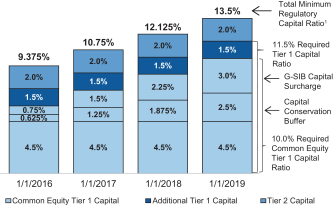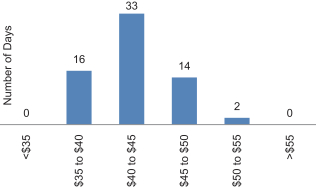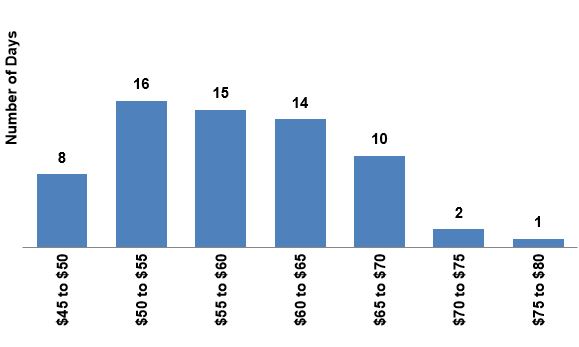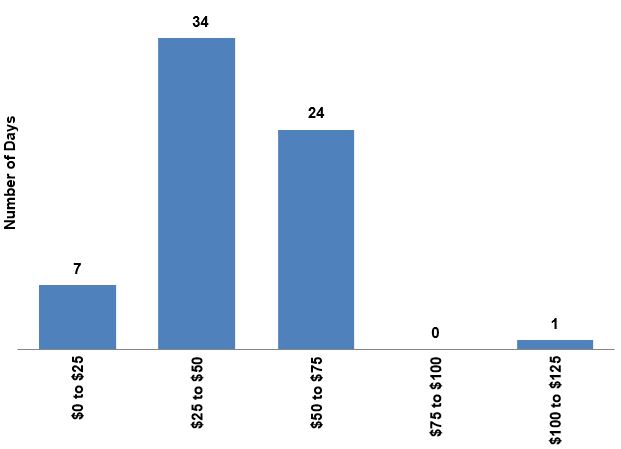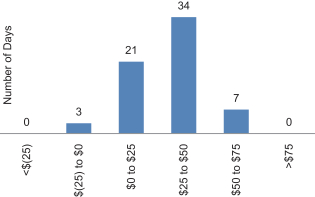☒
EXCHANGE ACT OF 1934
OR
☐ TRANSITION REPORT PURSUANT TO SECTION 13 OR 15(d) OF THE SECURITIES
EXCHANGE ACT OF 1934
2020


| Delaware | 1585 Broadway | 36-3145972 | (212) | 761-4000 | ||||
(State or other jurisdiction of incorporation or organization) |
New York, | NY | 10036 | (I.R.S. Employer Identification No.) | (Registrant’s telephone number, including area code) | |||
| (Address of principal executive offices, including zip code) | ||||||||
Securities registered pursuant to Section 12(b) of the Act: |
| |
| Title of each class | Trading Symbol(s) |
Name of exchange on which registered |
| Common Stock, $0.01 par value | MS | New York Stock Exchange |
| Depositary Shares, each representing 1/1,000th interest in a share of Floating Rate | MS/PA | New York Stock Exchange |
| Non-Cumulative Preferred Stock, Series A, $0.01 par value | ||
| Depositary Shares, each representing 1/1,000th interest in a share of Fixed-to-Floating Rate | MS/PE | New York Stock Exchange |
| Non-Cumulative Preferred Stock, Series E, $0.01 par value | ||
| Depositary Shares, each representing 1/1,000th interest in a share of Fixed-to-Floating Rate | MS/PF | New York Stock Exchange |
| Non-Cumulative Preferred Stock, Series F, $0.01 par value | ||
| Depositary Shares, each representing 1/1,000th interest in a share of Fixed-to-Floating Rate | MS/PI | New York Stock Exchange |
| Non-Cumulative Preferred Stock, Series I, $0.01 par value | ||
| Depositary Shares, each representing 1/1,000th interest in a share of Fixed-to-Floating Rate | MS/PK | New York Stock Exchange |
| Non-Cumulative Preferred Stock, Series K, $0.01 par value | ||
| Depository Shares, each representing 1/1000th interest in a share of 4.875% | MS/PL | New York Stock Exchange |
| Non-Cumulative Preferred Stock, Series L, $0.01 par value | ||
| Global Medium-Term Notes, Series A, Fixed Rate Step-Up Senior Notes Due 2026 | MS/26C | New York Stock Exchange |
| of Morgan Stanley Finance LLC (and Registrant’s | ||
| Morgan Stanley Cushing® MLP High Income Index ETNs due March 21, 2031 | MLPY | NYSE Arca, Inc. |
Large accelerated filer | ☒ | Accelerated | ☐ |
| |||||
| ☐ | Smaller reporting company | |||||||
| ☐ | Emerging growth company | ☐ | ||||||
| Table of Contents | Part | Item | Page | |||||
| I | 1 | |||||||
Management’s Discussion and Analysis of Financial Condition and Results of Operations | 2 | 1 | ||||||
| 1 | ||||||||
| 2 | ||||||||
| 7 | ||||||||
| 18 | ||||||||
| 18 | ||||||||
| 19 | ||||||||
| 19 | ||||||||
| 3 | 32 | |||||||
| 4 | 42 | |||||||
| 43 | ||||||||
| 1 | 44 | |||||||
| 44 | ||||||||
| 44 | ||||||||
| 45 | ||||||||
Consolidated Balance Sheets (Unaudited at September 30, 2017) | 46 | |||||||
Consolidated Statements of Changes in Total Equity (Unaudited) | 47 | |||||||
| 48 | ||||||||
| 49 | ||||||||
| 49 | ||||||||
| 50 | ||||||||
| 51 | ||||||||
| 63 | ||||||||
| 67 | ||||||||
| 70 | ||||||||
| 72 | ||||||||
| 75 | ||||||||
| 75 | ||||||||
| 75 | ||||||||
| 76 | ||||||||
12. Variable Interest Entities and Securitization Activities | 80 | |||||||
| 83 | ||||||||
| 86 | ||||||||
| 88 | ||||||||
| 88 | ||||||||
| 89 | ||||||||
| 89 | ||||||||
| 89 | ||||||||
| 91 | ||||||||
| 92 | ||||||||
| II | 95 | |||||||
| 1 | 95 | |||||||
| 2 | 96 | |||||||
| 6 | 96 | |||||||
| E-1 | ||||||||
|
|
S-1 |
| |||||
2020
| Table of Contents | Part | Item | Page | ||
| II | 1A | ||||
| I | |||||
| I | 2 | ||||
| I | 3 | ||||
| I | 1 | ||||
| II | |||||
| II | 1 | ||||
| II | 2 | ||||
| I | 4 | ||||
| II | 6 | ||||
S-1 | |||||
website.
Amended and Restated Certificate of Incorporation;
Amended and Restated Bylaws;
| • | Amended and Restated Certificate of Incorporation; |
| • | Amended and Restated Bylaws; |
| • | Charters for our Audit Committee, Compensation, Management Development and Succession Committee, Nominating and Governance Committee, Operations and Technology Committee, and Risk Committee; |
| • | Corporate Governance Policies; |
| • | Policy Regarding Corporate Political Activities; |
| • | Policy Regarding Shareholder Rights Plan; |
| • | Equity Ownership Commitment; |
| • | Code of Ethics and Business Conduct; |
| • | Code of Conduct; |
| • | Integrity Hotline Information; |
| • | Environmental and Social Policies; and |
| • | Sustainability Report. |
Charters for our Audit Committee, Compensation, Management Development and Succession Committee, Nominating and Governance Committee, Operations and Technology Committee, and Risk Committee;
Corporate Governance Policies;
Policy Regarding Corporate Political Activities;
Policy Regarding Shareholder Rights Plan;
Equity Ownership Commitment;
Code of Ethics and Business Conduct;
Code of Conduct;
Integrity Hotline Information; and
Environmental and Social Policies.
Our Code of Ethics and Business Conduct applies to all directors, officers and employees, including our Chief Executive Officer, Chief Financial Officer and Deputy Chief Financial Officer. We will post any amendments to the Code of Ethics and Business Conduct and any waivers that are required to be disclosed by the rules of either the SEC or the New York Stock Exchange LLC (“NYSE”) on our internet site.website. You can request a copy of these documents, excluding exhibits, at no cost, by contacting Investor Relations, 1585 Broadway, New York, NY 10036(212-761-4000). The information on our internet sitewebsite is not incorporated by reference into this report.
| 1 | September 2020 Form 10-Q | |
See the “Glossary of Common Terms and Acronyms” for the definition of certain terms and acronyms used throughout this Form 10-Q.
research.
small tomedium-sized businesses/ businesses and institutions coveringcovering: brokerage and investment advisory services,services; financial and wealth planning services,services; stock plan administration services; annuity and insurance products, creditproducts; securities-based lending, residential real estate loans and other lending products, bankingproducts; banking; and retirement plan services.
| September 2020 Form 10-Q | 2 |
| Management’s Discussion and Analysis |   | |
Consolidated Results
Results—Three Months Ended September 30, 2020
| • | On October 2, 2020, we completed the acquisition of E*TRADE Financial Corporation (“E*TRADE”). For further information, see “Business Segments—Wealth Management.” |

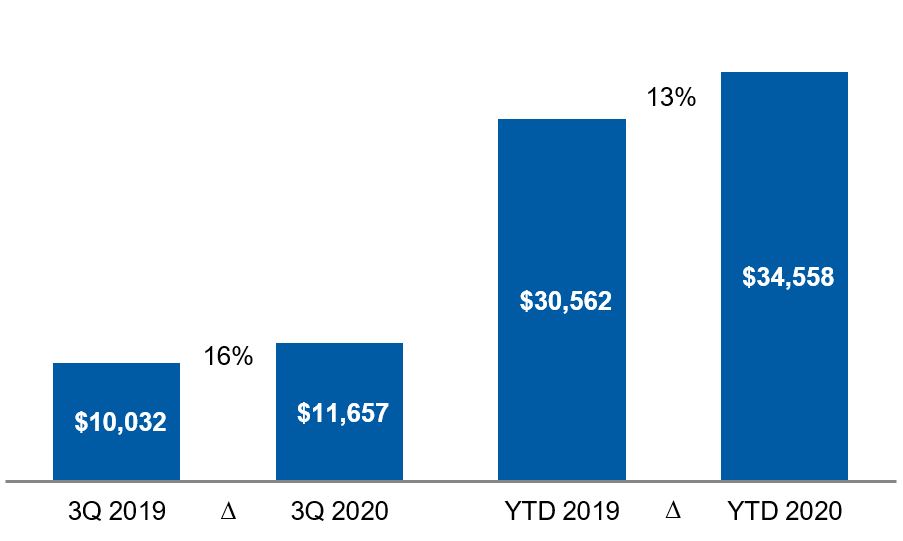

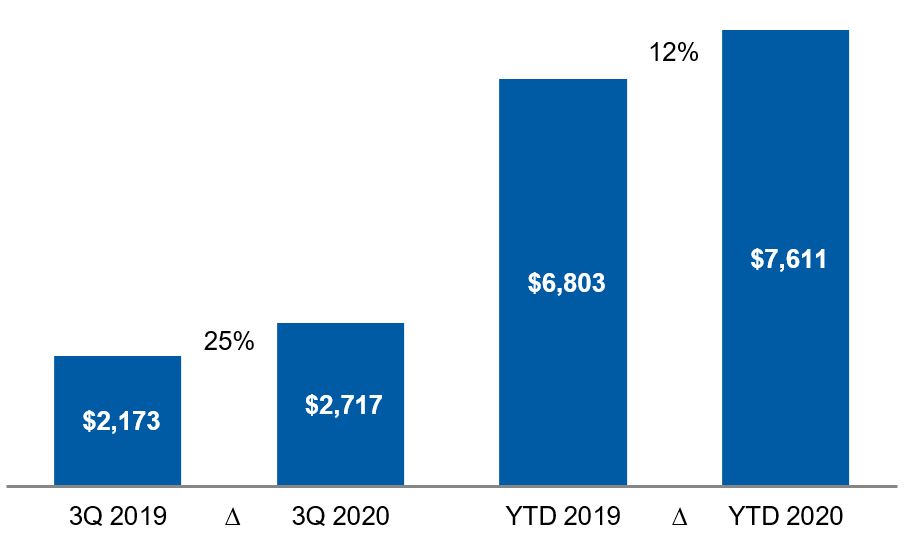
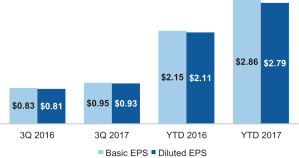
|
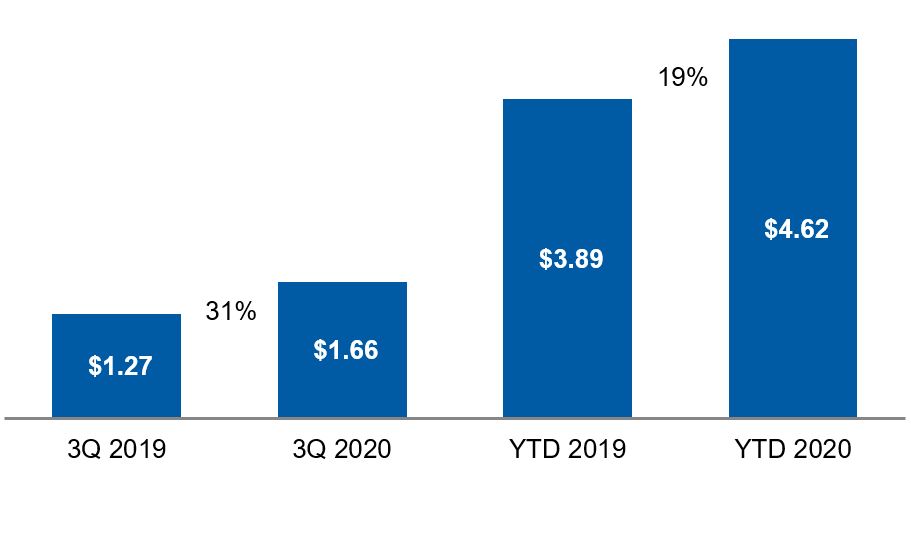
We reported net revenues of $28,445$34,558 million in the nine months ended September 30, 20172020 (“current year period,” or “YTD 2017”2020”), compared with $25,610$30,562 million in the nine monthsperiod ended September 30, 20162019 (“prior year period,” or “YTD 2016”2019”). For the current year period, net income applicable to Morgan Stanley was $5,468$7,611 million, or $2.79$4.62 per diluted common share, compared with $4,313$6,803 million or $2.11$3.89 per diluted common share, in the prior year period.
| 3 | September 2020 Form 10-Q | |
| Management’s Discussion and Analysis |  |
1
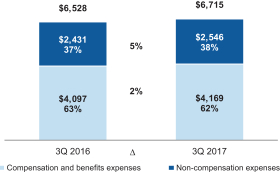

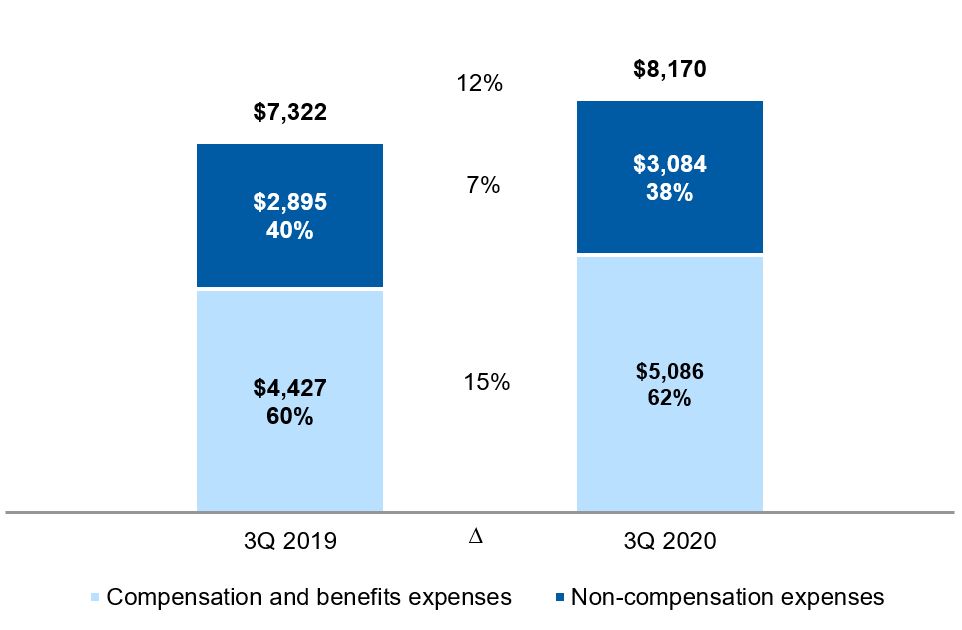

| 1. | The percentages on the bars in the chart represent the contribution of compensation and benefits expenses and non-compensation expenses to the total. |
| • | Non-compensation expenses of $9,166 million in the current year period increased 9% from the prior year period, primarily as a result of higher volume-related expenses, an increase in the provision for credit losses for lending commitments and off-balance sheet instruments, and increased information processing and communication expenses. These increases were partially offset by a decrease in marketing and business development expenses. |
| September | ||||
| Management’s Discussion and Analysis |   | |
|
Non-compensation expenses were $2,546 million in the current quarter and $7,626 million in the current year period compared with $2,431 million in the prior year quarter and $7,213 million in the prior year period, representing a 5% and a 6% increase, respectively. These increases were primarily as a result of higher volume-driven expenses. In addition,non-compensation expenses increased in the current year period due to a provision related to a United Kingdom (“U.K.”) indirect tax (i.e. value-added tax or “VAT”) matter and higher litigation costs. For further discussion of the U.K. VAT matter, see “Institutional Securities—Investments, Other Revenues,Non-interest Expenses and Other Items—Other Items” herein.
Expense Efficiency Ratio
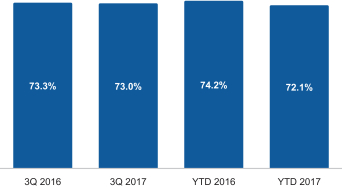
The expense efficiency ratio was 73.0% in the current quarter and 72.1% in the current year period. The expense efficiency ratio was 73.3% in the prior year quarter and 74.2% in the prior year period (see “SelectedNon-Generally Accepted Accounting Principles(“Non-GAAP”) Financial Information” herein).
Return on Average Common Equity

The annualized return on average common equity (“ROE”) was 9.6% in the current quarter and 9.8% in the current year period. The annualized ROE was 8.7% in the prior year quarter and 7.7% in the prior year period (see “SelectedNon-Generally Accepted Accounting Principles(“Non-GAAP”) Financial Information” herein).
2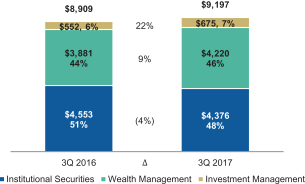

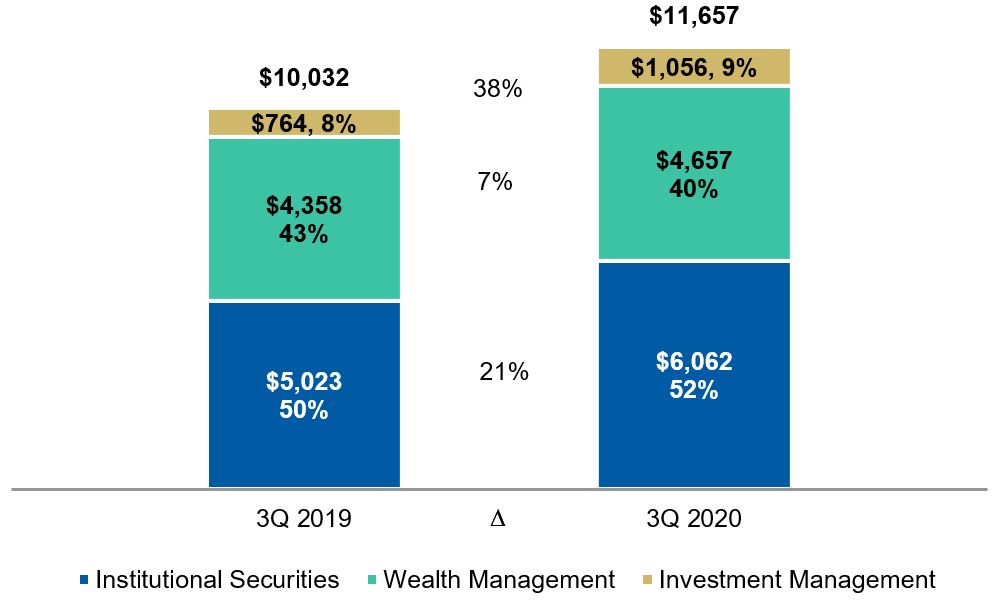
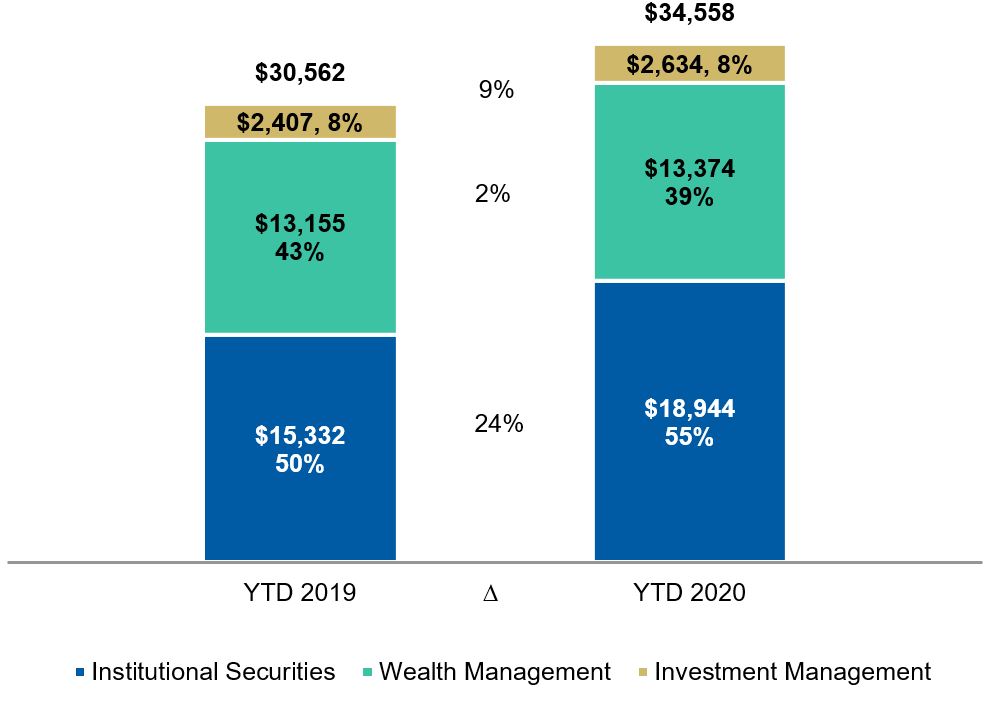
 |
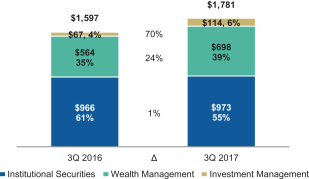
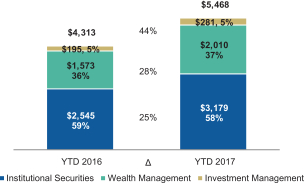
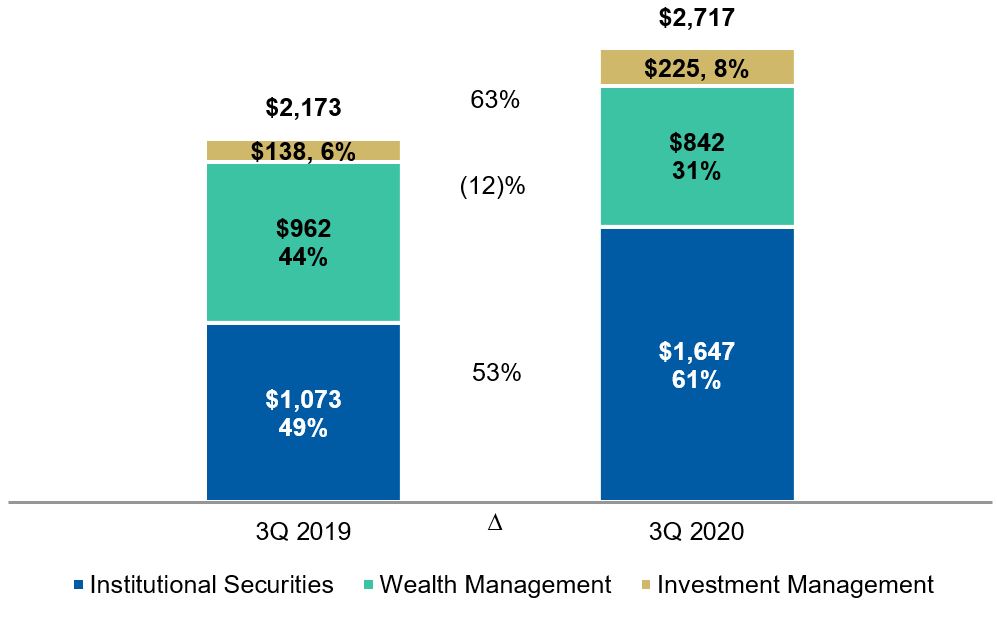
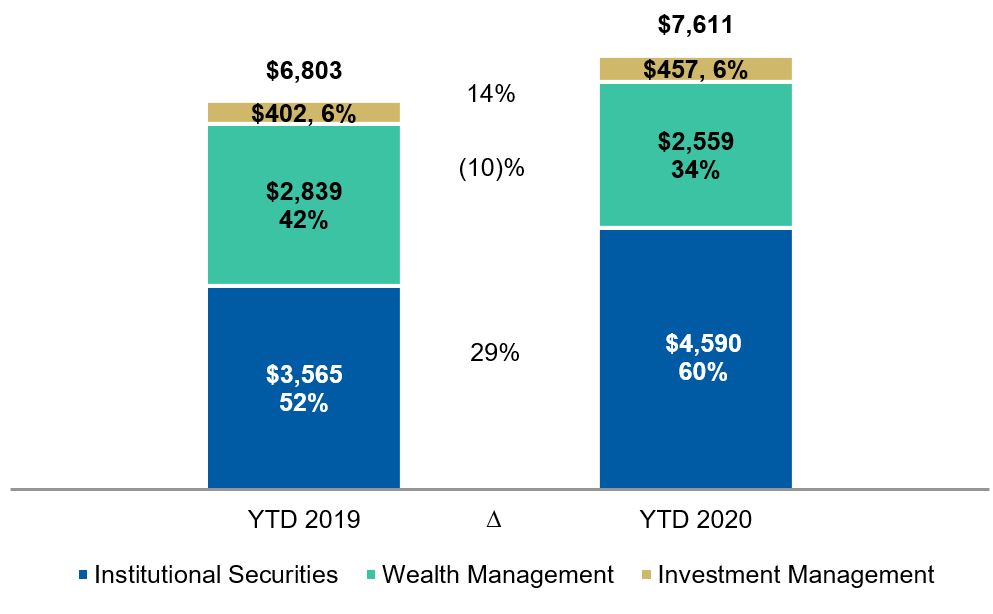
| 1. | The percentages on the bars in the charts represent the contribution of each business segment to the |
| |
| • | Institutional Securities net revenues of |
| 5 | September 2020 Form 10-Q | |
| Management’s Discussion and Analysis |  |
| • | Institutional Securities net revenues of $18,944 million in the current year period |
| |
| • | Wealth Management net revenues of |
Institutional Securities net revenues of $4,376 million in the current quarter and $14,290 million in the current year period decreased 4% from the prior year quarter and increased 11% from the prior year period. The current quarter results primarily reflected lower revenues from fixed income sales and trading, partially offset by higher underwriting and advisory revenues. The current year period results primarily reflected higher revenues from underwriting and fixed income sales and trading.
WealthInvestment Management net revenues of $4,220 million in the current quarter and $12,429$2,634 million in the current year period increased 9% both from the prior year quarter and the prior year period. The current quarter and the current year period results reflected growth in assetprimarily due to higher Asset management fee revenues and Net interest income.
Investment Management net revenuesas a result of $675 million in the current quarter and $1,949 million in the current year period increased 22% from the prior year quarter and increased 21% from the prior year period. The current quarter and the current year period results primarily reflected higher carried interest and investment gains and growth in asset management fee revenues.
The percentages on the bars in the charts represent the contribution of each region to the total.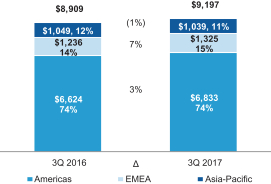
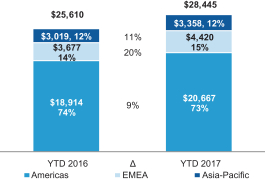
EMEA—Europe, Middle East and Africa

1. 2. For a discussion of how the geographic breakdown forof net revenues is determined, see Note 2120 to the consolidated financial statements in the 20162019 Form10-K.
| September | ||||
